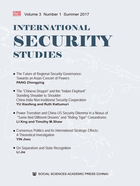
3 Regional War in Asia a Possibility
In and around 2014 as the world marked the 100th anniversary of the outbreak of WWI, the international academia (notably the European academia) came up with a historical analogy between Europe in the past (early 20thcentury) and Asia of the present (early 21st century): Europe in the past walked into conflicts and wars, likewise there is a chance for Asia of the present to do the same.
Today’s Asia is different from yesterday’s Europe; the 21st century is different from the 19th and 20th centuries. But even though it reveals nothing more than just the similarity between yesterday’s Europe and today’s Asia, such an analogy is significant: the lessons drawn from yesterday’s Europe and the solutions to its issues can shed some light on how today’s Asia can approach the difficult challenges it is facing now.
In the midst of a lasting economic boom, the issue of regional security in Asia remained on the back burner; the result is the security challenges in the region continued to accumulate in the past 40 years (from the 1970s until now). The situation is like stacking eggs, to quote a Chinese saying, and the risks are self-evident. The danger doesn’t stop at common disputes, violence and conflicts, but lies in wars involving one or more major powers. Such wars are not destined to happen, but not exactly impossible.[8] There’s always been the possibility of a war on the Korean Peninsula. The prevention of war is the fundamental premise of foreign policy decision-making for all countries involved. “What should be the fundamental premise of South Korea’s foreign policy towards North Korea? Undoubtedly, it is the prevention of war.”[9]
Amidst the discussions, some prominent theories of international relations suggest one of the consequences of power transition is the scenario where the players end up in “Thucydides Trap.” “Thucydides Trap” reminds both the emerging power and the hegemony to avoid conflicts. Of course, the emerging power-hegemony analytic framework is highly simplified. The emerging process is not necessarily sustainable; it is not consistently high-speed and is susceptible to slow-down or interruption. The relationship between the emerging power and the hegemon is not necessarily irreconcilable, in fact, both the emerging power and the hegemony’s roles in international order are closely related, the emerging power is gradually becoming a main contributor to the international order, the emerging power and the hegemon coexist and cooperate under the same order.
On the one hand, continued economic prosperity and vigor is an important, if not a major factor in peace (according to the West’s traditional “Peace through Trade” theory and China’s “Peace through Development” theory), and such peace is likely to last a long time. (Within a certain region, member countries, in turn, going through economic boom and development becomes a major theme in regional affairs, for instance, between the 1970s and 1990s Japan led economic development in the West Pacific region in what was described as the Flying Geese Paradigm.)
On the other hand, the economic prosperity and vigor were possible thanks to order known as Pax Pacifica.[10] This order guaranteed the economic development and vigor for Japan and some other allies of the United States. Later on, the economic development and vigor of other Asian countries also originated from this order.
However, the existing Pax Pacifica is limited in certain aspects: first, it is centered on the United States of America, and was thus often referred to as the American Order; second, admission is not unconditional, especially in terms of political and security arrangements, non-US allies are either not included, or given peripheral positions if they are. The arrangements are many and varied within this order, but no framework exists that includes all countries and interest groups. As a result, order and peace are not guaranteed. Once the rapid economic development that sustains regional peace slows down to a dangerous level, tension, conflicts or even war could take place in the region. This is exactly the historic juncture facing the Asia-Pacific region. Meanwhile, the relationship between this order and non-US ally countries is growing even more complex: from the perspective of the order, the will and capacity have weakened to accept, accommodate and integrate emerging, non-US ally countries (such as China), but from the perspective of these countries, they are creating a regional order that runs parallel to the existing one. Under such circumstances, competition over the international order could escalate.
Within Europe, international war has become history, even if the European Union is no longer, it is hard to envision a repetition of the history of war that endured before 1945. But Asia is a totally different story, since the 1970s international relations have been dominated by economic development, conflicts had been ignored, but not fundamentally eradicated like in Europe. Current issues in international relations, territorial disputes, conflicts brought about by development and nationalism could all become the causes of an international war in the region.